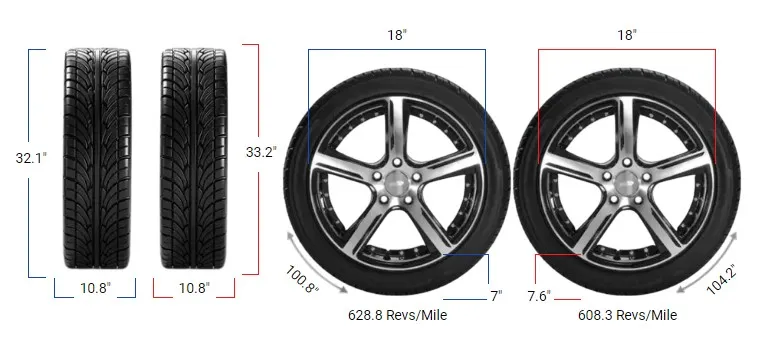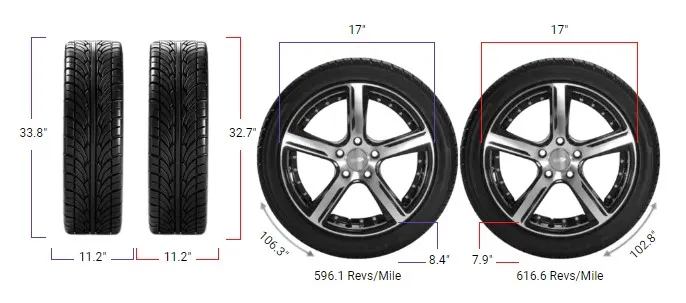Tire Size 33×12.50r20 vs 305/55r20

Switching from 33×12.50r20 to 305/55r20 tires involves a subtle change in size and performance. Let’s explore these changes and their potential impacts.
- Slightly larger diameter increases ground clearance by 0.19 inches
- Narrower width may marginally improve fuel efficiency and handling
- Taller sidewall height could result in a slightly softer ride
- Speedometer will read about 0.6% slower than actual speed
- Tire revolutions decrease by 3.46 per mile minimally affecting odometer readings

Fitment Guide
The diameter difference between 33×12.50r20 and 305/55r20 tires is only 0.6%, well within the acceptable range of plus or minus 3%.
Therefore, this interchange is generally recommended without requiring significant adaptations to prevent issues like rubbing or clearance problems.
On-Road Impact
The switch to 305/55r20 tires will have subtle effects on your vehicle’s on-road performance. Here’s what you might notice:
- Gas Mileage: The slightly larger diameter of the 305/55r20 tires means they make fewer revolutions per mile (3.46 less, or a 0.6% decrease). This could lead to a marginal improvement in fuel efficiency due to reduced rolling resistance, but the difference may be too small to notice in real-world driving.
- Speedometer Accuracy: Your speedometer will be minimally affected by this change. When it reads 20 mph, your actual speed will be about 20.11 mph. This 0.6% difference is negligible and unlikely to cause any practical issues with speed limits or arrival times.
- Ride Comfort: The taller sidewall height (0.09 inches or 1.4% more) of the 305/55r20 tires may result in a slightly softer ride. You might feel fewer road imperfections and bumps, but the difference will be subtle.
- Aesthetics: The narrower width (0.51 inches or 4.1% less) of the 305/55r20 tires will change your vehicle’s appearance slightly. It may look a bit less aggressive, but the difference is minimal and may not be noticeable to most observers.
- Handling: The narrower width could marginally improve steering response and potentially enhance cornering ability on dry pavement. However, it might slightly reduce grip in wet conditions. These changes are likely to be very subtle and may only be noticeable to very attentive drivers.

Off-Road Impact
For off-road enthusiasts, the switch to 305/55r20 tires will have minor effects:
- Ground Clearance: The slightly larger diameter will increase your vehicle’s ground clearance by about 0.095 inches (half of the 0.19-inch diameter increase). This minuscule change is unlikely to make any noticeable difference in off-road capability.
- Traction: The narrower width of the 305/55r20 tires might provide marginally better performance in mud or snow due to increased ground pressure. However, it could slightly reduce traction on loose surfaces like sand or gravel. These differences are likely to be minimal in most off-road situations.
- Durability: The slightly taller sidewall height of the 305/55r20 tires makes them marginally more resistant to damage from rocks and other off-road hazards. This could potentially lead to slightly improved durability, but the difference is unlikely to be significant.
- Flotation: The reduced width of the 305/55r20 tires will provide slightly less flotation in soft terrains like sand or deep mud. However, the difference is small enough that it’s unlikely to significantly impact your vehicle’s performance in these conditions.
33×12.50r20 vs 305/55r20
This comparison table highlights the key differences between the 33×12.50R20 and 305/55R20 tire sizes.
| Feature | 33×12.50R20 | 305/55R20 | Difference |
|---|---|---|---|
| Diameter inches (mm) | 33.02 (838.72) | 33.21 (843.5) | 0.19 (4.78) +0.6% |
| Width inches (mm) | 12.52 (318) | 12.01 (305) | -0.51 (-13) -4.1% |
| Circumference inches (mm) | 103.74 (2634.92) | 104.33 (2649.93) | 0.59 (15.02) +0.6% |
| Sidewall Height inches (mm) | 6.51 (165.36) | 6.6 (167.75) | 0.09 (2.39) +1.4% |
| Revolutions per mile (km) | 610.78 (379.52) | 607.31 (377.37) | -3.46 (-2.15) -0.6% |
| Speedo Reading | 20 mph | 20.11 mph | +0.11 mph |
What is the Difference Between 33×12.50r20 and 305/55r20?
The main differences between 33×12.50r20 and 305/55r20 tires are in their dimensions. The 305/55r20 is slightly taller, with a diameter of 33.21 inches compared to 33.02 inches for the 33×12.50r20.
However, the 33×12.50r20 is wider at 12.52 inches versus 12.01 inches for the 305/55r20. The 305/55r20 also has a slightly taller sidewall and makes fewer revolutions per mile.

Can I Use 305/55r20 Instead of 33×12.50r20?
Yes, you can use 305/55r20 instead of 33×12.50r20. The difference in diameter between these two tire sizes is only 0.6%, which is well within the generally accepted 3% threshold for tire replacement.
This small size difference should not significantly impact vehicle performance, safety, or accuracy of speedometer and odometer readings.
How Much Taller Is a 305/55r20 Tire Than a 33×12.50r20?
A 305/55r20 tire is 0.19 inches (4.78 mm) taller than a 33×12.50r20 tire. The 305/55r20 has a diameter of 33.21 inches (843.5 mm), while the 33×12.50r20 has a diameter of 33.02 inches (838.72 mm). This represents a 0.6% difference in height.
How Much Wider is a 33×12.50r20 Tire Than a 305/55r20?
A 33×12.50r20 tire is 0.51 inches (13 mm) wider than a 305/55r20 tire. The 33×12.50r20 has a width of 12.52 inches (318 mm), while the 305/55r20 has a width of 12.01 inches (305 mm). This represents a 4.1% difference in width.
Our Observation
Switching from 33×12.50r20 to 305/55r20 tires offers a mix of minor benefits and drawbacks, but the overall impact is relatively insignificant.
On-road, you may experience a slightly softer ride and marginally improved fuel efficiency, but these changes are likely to be barely noticeable. Off-road, the differences in performance are even less pronounced, with only minimal changes in traction and flotation.
The 0.6% difference in diameter is well within acceptable limits, making this switch generally safe and unlikely to require vehicle modifications.
Ultimately, the decision to switch may come down to personal preference or tire availability rather than performance considerations.



